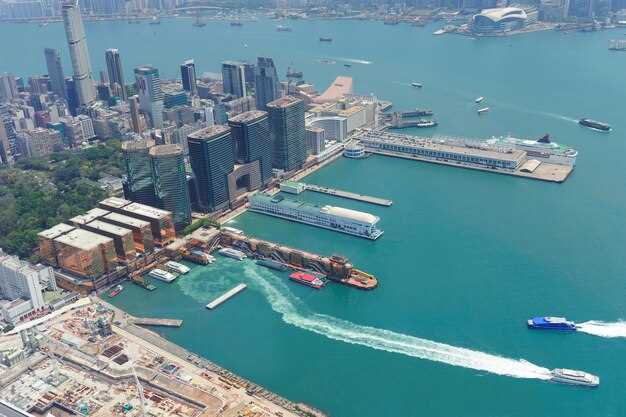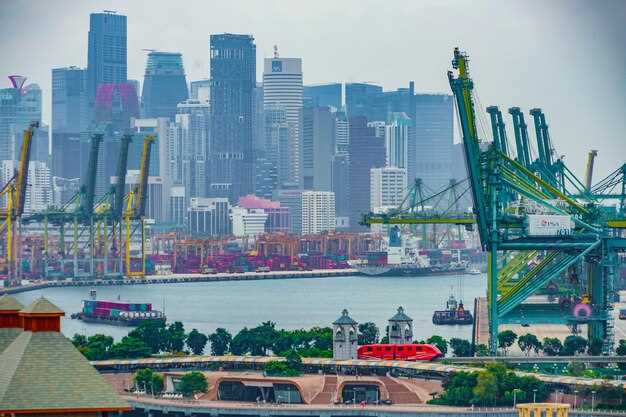Adopt a cross-border freight plan anchored in Singapore’s world-class ports to slash turnaround times and lift capacity, while giving you direct control over critical cargo flows. The port handles about 37 million TEUs annually, with a large share of transshipment that keeps regional supply chains highly fluid and resilient.
Strengthen third-party partnerships by offering shared data platforms, predictable berthing, and value-added services such as inland pickup, container repair, and documentation handling to differentiate from competition. A tighter yard planning and real-time berth optimization reduce idle time, improving turnaround for carriers serving americas-bound freight.
This continued automation across quay cranes, automated yard moves, and integrated terminal operating systems boosts efficiency, enabling more capacity without expanding land footprint. The factor for success is not only port throughput but also how well data flows among carriers, shippers, and customs offices to cut dwell time.
To keep the momentum, Singapore will fortify cross-border corridors with unified data standards, expand capacity through phased terminal expansions, and maintain strict cargo control at the gates. The approach will rely on public-private coordination and continued investment that will be crucial for resilience, benefiting shippers, carriers, and economies across the americas and Asia-Pacific.
Plan: Singapore’s World-Class Ports and Global Trade

Invest in an integrated port-tech program, pursuing several related initiatives to boost delivery speed across terminals and strengthen Singapore’s gateway role, targeting a 15-20% uplift in container throughput within five years by aligning automation, data sharing, and hinterland links.
Focus on cost-effective, full-scope solutions designed to scale with growing demand while prioritizing sustainable operations and a cleaner environment, providing real-time visibility across the supply chain and reducing turnaround times for ships, cargo, and trucks.
License and compliance play a central role: establish a clear licensing framework for automation, autonomous equipment, and data-sharing platforms to accelerate adoption without compromising safety or security, while standardizing performance metrics across all partners serving the port complex.
Singapore’s ports serve as gateways to markets in the region and beyond; by coordinating several terminals and hinterland connections with other regional hubs, the network remains resilient, delivering reliable delivery windows for exporters and importers while maintaining competitive costs for shippers seeking optimal route options.
Table: Key metrics and actions for plan execution
| KPI | Target / Current | Cronologie |
|---|---|---|
| Container throughput | ≈37 million TEUs annually | 2023–2028 |
| Investment in modernization | SGD 20–25 billion | 2019–2029 |
| Emissions intensity (CO2e per TEU) | −20% | by 2030 |
| Digital innovations deployed | 10+ initiatives | ongoing |
| Gateway connectivity | 4 coastal gateways and hinterland corridors | by 2026 |
Reduce Vessel Turnaround Time with Real-Time Berth Allocation
Implement an RBA platform now and begin a three-month trial at two busy berths to measure a 20–35% reduction in average waiting times and a 10–20% drop in quay-crane idle periods.
Integrate live data from AIS, berth status, tide models, and weather forecasts, feeding a dynamic scheduler that adapts in real time.
This approach delivers clearer visibility, minimizes unnecessary shifts, and trims dwell time across dockside operations.
Inputs include ETA, inbound speed, draft, channel constraints, tide windows, and pilot availability.
Resources such as tugs, line handlers, and mooring crews are allocated on a rolling basis.
Rules assign priority to time-critical cargo and to stable arrival windows.
An engine blends deterministic rules with AI forecasts to issue slots with limited reassignments.
Data handling requires an oversight framework, clear data standards, and secure access controls.
Decision rights and escalation paths should be defined in policy documents.
Meetings should include terminal operators, shipping lines, pilots, and authorities to align incentives and reduce conflicts.
Metrics to monitor include berth occupancy, average docking time, and the number of slot changes.
Targets include a 15-25% drop in docking delays and a 5-10% improvement in overall cycle time.
Track cargo volumes and energy use by tug operations; expect fuel savings in the single-digit to low double-digit percentages.
Roll out in phases: pilot at two berths, expand to additional docks once stability is shown.
Publish real-time alerts and dashboards for operators, yard staff, and ship crews.
Establish a formal change-control process to minimize disruption and keep reassignments minimal.
Result: faster turnarounds, higher throughput, and greener operations.
Improve Cargo Visibility through Digital Data Sharing and Tracking
Adopt a singapore-based, interoperable data-sharing backbone that connects lines, terminals, warehouses, and road/rail segments, providing full end-to-end cargo visibility and automating status updates for every vehicle and container.
Launch cross-agency initiatives to standardize data definitions, privacy controls, and access rights, reinforced by clear policy and SLAs, so partners trust and share real-time events.
Deploy a real-time tracking layer that ingests data from GPS on vehicles, RFID scans, and container IDs, feeding a single dashboard; this enhances transparency and reduces dwell times across hubs.
Comparative analytics allow shippers and port authorities to compare performance across lines and modes, while singapore-based operators leverage this data to optimize routing, reduce congestion, and improve customer experience.
Automating break-bulk and mixed cargo visibility requires specialized data models; the system handles unit-level and piece-level events, ensuring full traceability of break-bulk cargo along the chain.
Policies align with global expectations, and a robust governance framework reinforces data quality, access controls, and audit trails, while encouraging continuous improvement across the ecosystem. Most stakeholders expect consistent policy, privacy, and data-quality standards to unlock reliable data exchange.
Leverage a scalable, singapore-based platform to integrate shipper, carrier, terminal, and customs data; this ecosystem enhances collaboration and enables business to respond quickly to disruptions, while supporting adaptation to evolving regulatory and market needs. The approach also allows operators to compare performance across markets and cargo types, reinforcing resilience for global trade.
Maximize Intermodal Throughput: Seamless Rail and Road Connectivity
Need a unified real-time control system that links rail shuttles, terminal gates, and trucking lanes; this approach continues to cut dwell times and improve predictability for multi-modal moves.
Recent investments in rail spur upgrades and road link reinforcements around the region support a multi-modal system that already boasted millions of teus annually, with cross-regional chains ready for further expansion.
To maximize throughput, align packaging standards with container handling; implement standard packaging across shipments to reduce load variation and optimize crane cycles; this reduces dwell times and improves reliability.
A freightamigos platform can coordinate trunk rail and road segments, offering a single link for shippers, forwarders, and carriers; early pilots in key crossroads terminals show a double-digit drop in empty backhaul miles and a lower carbon footprint.
Investments in the region’s intermodal middleware create opportunities in the port and logistics sector; a targeted strategy combines public capital with private investment and follows a phased approach.
Opinions vary on sequencing; some favor near-term electrification or broader automation; the plan keeps carbon reduction as a goal, focusing on modal shift.
Strengthen Port Security, Compliance, and Resilience Planning
Adopt a unified, risk-based security and resilience program that integrates physical and cyber security, environmental safeguards, and continuity planning across the port network to reduce risk, streamline license verification, and protect supply chains from disruptions. The program offers measurable benefits for businesses, the sector, and governments, and can be a stable driver for sustained performance.
- Establish governance and license-driven compliance: form a cross-sector port security council, codify roles, and define license verification and reporting processes that align with national regulations and international best practices; designate a steady data flow between the company, authorities, and vendors, and adapt to the changing threat landscape.
- Threat assessment and facility hardening: map vulnerabilities across yard areas, fuel storage areas, and trans zones; implement layered access control, perimeter fencing, cameras, lighting, and intrusion detection beyond the basics; run monthly drills to validate response.
- Data and technology backbone: deploy electronic manifests and real-time sensor data; create a secure network with encrypted channels, standardized data formats, and API connections to government agencies; use anomaly detection to flag suspicious activity whether from internal or external sources.
- Operational resilience: build business continuity plans that cover power, comms, water, and alternate routes for critical cargo; maintain redundant systems and environmental safeguards; conduct quarterly incident simulations and annual tabletop exercises to validate recovery objectives and data integrity under stress.
- Processes and compliance modernization: standardize security checks and cargo handling procedures; digitalize routine verifications such as licenses, permits, and environmental compliance; implement automated audits and continuous improvement loops; monitor KPIs across the sector.
- People, training, and culture: roll out targeted training programs for stevedoring crews, yard staff, and security teams; use clear procedures and multilingual materials; designate incident handlers and data custodians who handles sensitive information.
- Investment, project management, and benefits: treat upgrades as a portfolio of projects; clearly define scope, milestones, and risk; allocate annual budgets in the millions; track benefits such as reduced incident losses, improved clearance times, and stronger environmental compliance; report progress to countries involved and seek continuous feedback from sector players.
Final note: a proactive, coordinated approach strengthens port security, reduces disruption risk, and reinforces trust among customers, partners, and authorities.
Advance Sustainability: Practical Measures to Lower Emissions and Energy Use
Install shore power at berths 1–6 now and extend to all active piers within the next five years to cut shipboard emissions by 40–60% during docking and reduce noise for nearby communities, benefiting the environment and confirming Singapore’s role as gateways for global trade.
Electrify quay cranes and yard equipment, pair with regenerative braking, and deploy on-dock battery storage. Combine with energy-efficient HVAC and LED lighting managed by smart controls to lower annual port energy consumption by roughly 25–40%.
Singapore sits as a well-positioned hub, one of the gateways for growth that links the southeast region with the Americas. The clarions from shippers and carriers demand reliable, low-emission delivery and faster routing. To meet these signals, the port ecosystem will lean on digital tools, robotics, and tailored programs that help operators operate cleaner and smarter.
- Shore power at berths reduces idle fuel burn and CO2 by 40–60% during docking; install robust electrical infrastructure and standardized connector ports.
- Electrify quay cranes and yard tractors; retrofit existing RTGs with energy recovery systems; target 75% electric drive adoption by 2030 with a staged rollout by terminals.
- On-dock microgrids combine solar PV, battery storage, and back-up gensets to supply critical loads; cut diesel genset use by more than 50% in peak periods.
- Upgrade lighting and building systems with sensors; expect a 30–40% drop in electricity use and better climate control for ships and staff.
- Adopt low-carbon fuels for carriers where bunkering infrastructure exists; encourage LNG-ready or hydrogen-ready vessels and ensure safe, scalable supply chains.
- Deploy robotics for yard handling, crane operations, and container tracking; improve cycle times and reduce idle container moves, lifting energy use by 15–25% per crane per shift.
- Use freightamigo-style routing tools to coordinate shippers, carriers, and delivery windows; reduce empty miles and shorten delivery times, improving speed and lowering freight costs.
- Implement digital dashboards aggregating data from millions of sensors to forecast demand, rapidly detect energy waste, and guide ongoing improvements enhancing resilience ahead of timelines.
- Tailored programs for shippers and carriers to consolidate deliveries, facilitate efficient routing, and reduce empty miles; faster delivery and improved overall efficiency.
- Strengthen regional freight corridors to connect Southeast Asian gateways with the Americas, supporting growth while keeping energy intensity low.

 Singapore’s World-Class Ports – Gateways to Global Trade">
Singapore’s World-Class Ports – Gateways to Global Trade">
